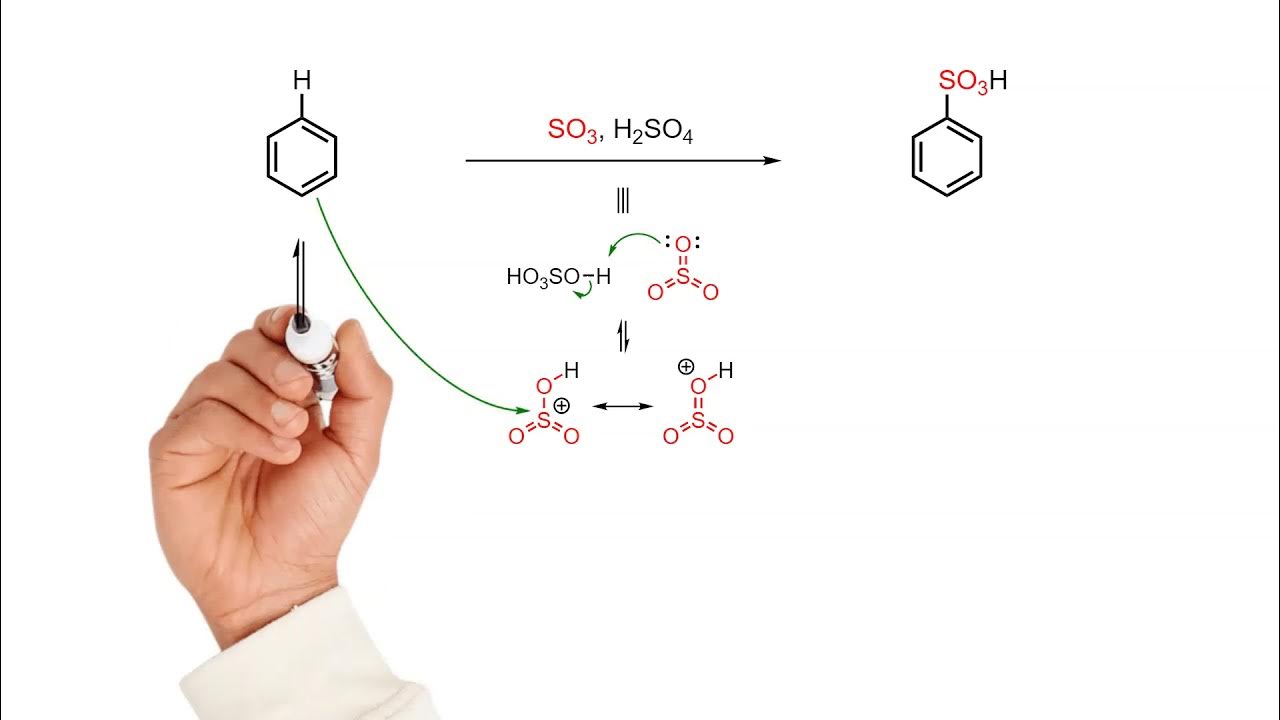Geometria Molecular | Teoria VSEPR | Teoria de Repulsão dos Pares de Elétrons da Camada de Valência
Summary
TLDRThis video script explores molecular geometry, focusing on the shapes and structures of molecules like sulfur dioxide (SO₂) and sulfur trioxide (SO₃). The speaker explains how electron clouds influence molecular shapes, such as angular geometry in SO₂ (due to a lone pair on sulfur) and trigonal planar geometry in SO₃ (with no lone pairs). The script also emphasizes the importance of considering only atom positions when determining molecular geometry, while electron pairs are disregarded. The content prepares viewers for more complex topics on molecules with four electron clouds.
Takeaways
- 😀 Molecules have a specific geometry based on the arrangement of atoms and electron clouds, such as linear, angular, or trigonal planar.
- 😀 The molecular geometry focuses on the positions of atoms, not the lone pairs of electrons, which only affect the electronic cloud arrangement.
- 😀 SO2 (Sulfur Dioxide) has an angular molecular geometry due to two bonding oxygen atoms and one lone pair on sulfur, causing a bent shape.
- 😀 The angle between the two oxygen atoms in SO2 is affected by the lone pair, which bends the molecule.
- 😀 In SO3 (Sulfur Trioxide), there are three bonding oxygen atoms and no lone pairs, leading to a trigonal planar molecular geometry.
- 😀 The bond angle in SO3 is approximately 120° due to its trigonal planar geometry, forming a flat triangular shape.
- 😀 Molecular geometry and electronic geometry are related but distinct, with the latter considering both atoms and electron pairs in space.
- 😀 SO2 has a total of three electron clouds (two bonds and one lone pair), while SO3 has three bonds and no lone pairs.
- 😀 The distinction between angular and trigonal geometry depends on the number of ligands (atoms) and lone pairs present in the molecule.
- 😀 To predict molecular geometry, one should count the number of bonding atoms (ligands) and lone pairs on the central atom to determine the shape.
- 😀 Understanding molecular geometry allows for predicting a molecule's shape, which is crucial for determining its chemical properties and behavior.
Q & A
What is the primary focus when discussing molecular geometry?
-Molecular geometry focuses on the position of atoms in space, disregarding non-bonding electron pairs, which do not influence the molecular geometry name.
How does the presence of non-bonding electron pairs affect molecular geometry?
-Non-bonding electron pairs influence the geometry by affecting bond angles, but they are not considered when naming the molecular geometry.
What is the molecular geometry of sulfur dioxide (SO₂)?
-Sulfur dioxide (SO₂) has an angular or bent molecular geometry due to two oxygen atoms and one non-bonding electron pair on the central sulfur atom.
What is the significance of electron clouds in determining molecular geometry?
-Electron clouds refer to the regions of electron density, and the number of clouds determines the geometry of the molecule. This includes both bonding and non-bonding pairs of electrons.
How does sulfur trioxide (SO₃) differ from sulfur dioxide (SO₂) in terms of molecular geometry?
-Sulfur trioxide (SO₃) has a trigonal planar geometry because it has three bonds to oxygen atoms and no lone pairs of electrons on the sulfur, while sulfur dioxide (SO₂) has an angular geometry due to the presence of a lone pair.
What is meant by trigonal planar geometry in a molecule?
-Trigonal planar geometry refers to a molecular shape where three bonds are arranged around a central atom in a flat, triangular configuration, with bond angles of 120°.
Why is the number of ligands important when determining molecular geometry?
-The number of ligands (atoms or groups attached to the central atom) plays a crucial role in determining whether the molecule adopts a linear, angular, trigonal, or other molecular geometry.
What does it mean for a molecule to have 'angular geometry'?
-A molecule with angular geometry has a bent shape, typically because of the presence of lone pairs or the arrangement of atoms causing bond angles less than 180°.
How does one differentiate between trigonal planar and angular geometries?
-Trigonal planar geometry occurs when a molecule has three bonding pairs of electrons with no lone pairs, forming a flat, triangular shape. Angular geometry occurs when there are lone pairs that cause a bend in the molecule's structure.
What is the role of bond angles in molecular geometry?
-Bond angles are critical in defining molecular geometry, as they determine the spatial arrangement of atoms within a molecule. Different geometries have characteristic bond angles that depend on the number and arrangement of bonding and non-bonding electron clouds.
Outlines

Dieser Bereich ist nur für Premium-Benutzer verfügbar. Bitte führen Sie ein Upgrade durch, um auf diesen Abschnitt zuzugreifen.
Upgrade durchführenMindmap

Dieser Bereich ist nur für Premium-Benutzer verfügbar. Bitte führen Sie ein Upgrade durch, um auf diesen Abschnitt zuzugreifen.
Upgrade durchführenKeywords

Dieser Bereich ist nur für Premium-Benutzer verfügbar. Bitte führen Sie ein Upgrade durch, um auf diesen Abschnitt zuzugreifen.
Upgrade durchführenHighlights

Dieser Bereich ist nur für Premium-Benutzer verfügbar. Bitte führen Sie ein Upgrade durch, um auf diesen Abschnitt zuzugreifen.
Upgrade durchführenTranscripts

Dieser Bereich ist nur für Premium-Benutzer verfügbar. Bitte führen Sie ein Upgrade durch, um auf diesen Abschnitt zuzugreifen.
Upgrade durchführen5.0 / 5 (0 votes)






